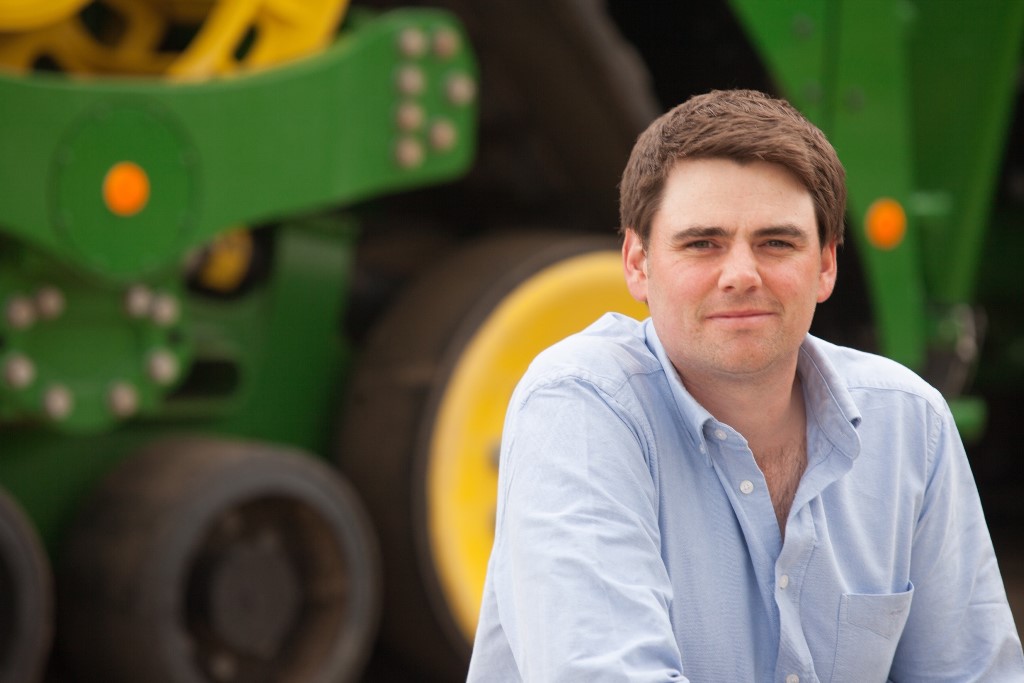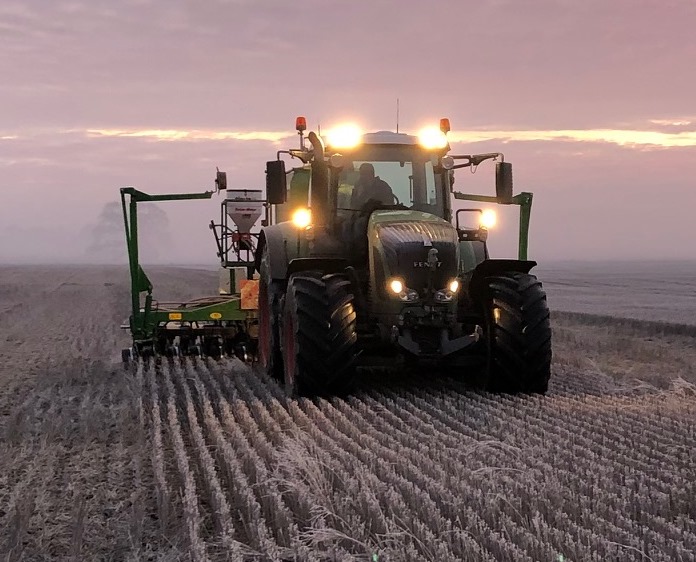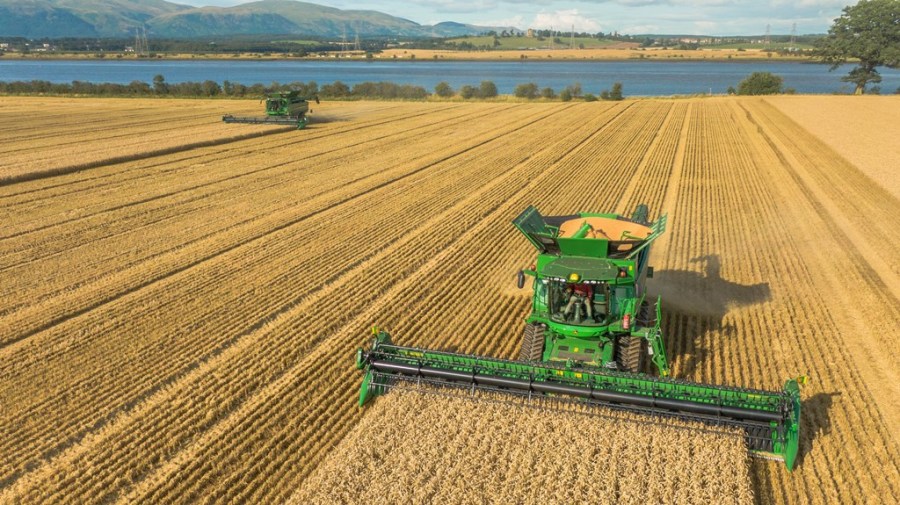A change in arable machinery can often expose variable farm performance where none was recognised before. CPM finds out how two growers are using on-farm trials to get a greater understanding.
We hadn’t seen the yield variability in quite such clarity before.
By Tom Allen-Stevens
More and more growers are using precision farming technologies to vary inputs of both seed and fertiliser, but few can pinpoint the efficiencies or benefits of what either brings. For two farmers in Agrii’s Digital Technology Farm network, it was a change in farm machinery that prompted them to seek a better understanding of varying inputs. That quest has led them to take part in a series of on-farm trials.
Game-changing technology
Farming 4000ha from west of Edinburgh to Duns in Berwickshire, Gus Seed can trace his family business’ involvement in precision agriculture back over 12 years. But the real game-changer for him came with a technology switch they took just three years ago.
“We upgraded the combines and invested in four John Deere 785i models, equipped with weigh cells in the grain tank and the latest telematics. It’s phenomenal technology and really opened our eyes to how the crop varies across a field,” says Gus.
The family partnership farms soils across West Lothian and Berwickshire that vary from easy-going loams to tougher, grey carse clay. Potatoes and vining peas accompany combinable crops on some of the kinder soils, while spring oats and barley are rotated with soft Group 3 and 4 winter wheat varieties, barley and oilseed rape.
“We’ve mapped the farm for P and K for the past twelve years and carried out a conductivity scan around eight years ago, but never really utilised it as much as I feel we should,” explains Gus.

Gus Seed had tried a number of crop canopy sensors to vary the rate of nitrogen fertiliser but never really felt these systems did much more than cost money.
Over the same time, the business had been using a number of crop canopy sensors to vary the rate of nitrogen fertiliser in real time as it was applied to the field. “I never really felt these systems did much more than cost us money,” he says.
That was until the upgrade in combine technology. “We hadn’t seen the yield variability in quite such clarity before, so decided it was time to get a better idea of what the variable-rate technology could do.”
Gus worked with his agronomist, Craig Herkes of Agrii and Rhiza specialist Jack Wilson to set up a trial last year across a field of OSR. “It was a 30ha field with soils that vary from sand to stiff clay, and there’d been quite a bit of over-winter pigeon damage, so there was plenty of crop variability to put to the test,” recalls Craig.
He based fertiliser applications on an N-Min test, varying the two fertiliser doses according to crop canopy and expected yield. The crop of Ergo high erucic-acid (HEAR) OSR had been drilled on 20 Aug following wheat with 150kg/ha of DAP and 100kg/ha of Calcifert applied at drilling through the 10m Horsch Sprinter. Application plans were drawn up in Rhiza using satellite-generated NDVI maps.
“It was the first time we’d used Rhiza,” notes Gus. “We applied two doses of liquid Nitroflo 24 + S (24% N, 7.5% SO₃) each delivering about 90kgN/ha. But while the flat rate was 294 l/ha, where we varied it, this ranged from 218-425 l/ha.
Once combined, the varied areas yielded up to an extra 1t/ha. “Admittedly this was only in the most extreme parts of the field, but there’s a considerable cost benefit to be had here, if applied properly, and it’s relatively easy to roll out across the business,” he says.
Gus has had similar reservations about variable-rate seeding technology he’s been using for the past five years, so both aspects are being put to the test this year as part of Agrii’s DTF on-farm trials.
The variable-rate N trial is in a field of KWS Barrel winter wheat, while the seed rate of a field of Laureate spring barley has been varied by as much as 40%. “I don’t think you really get the benefits from the system unless you’re prepared to vary over a wide range – 10-20% isn’t enough,” maintains Gus.
The tramline trials will be harvested and the data from the yield monitors processed through the ADAS Agronomics model which delivers statistical confidence to on-farm trials. In an additional trial, levels of nutrients applied to part of a field of Elation winter wheat have been varied according to the results of tissue testing carried out through the season.
“This links Rhiza with the small plot trials work carried out in this area by Agrii across its technology centres,” explains Craig. “Tissue samples are taken before each of the major spray timings and analysed for a whole range of macro and micronutrients with applications made according to the results. The system adapts to the season and it’s a very efficient way of feeding your crop with everything it needs.”
For Gus, manganese is a nutrient routinely applied. “The testing picked up that we have been slightly low in potassium, calcium, magnesium and zinc. It’s the extra components that make the difference – I wonder if we sometimes focus too much on the major elements and not enough on the micronutrients,” he notes.
While he’s looking forward to the results of the trials, he’d be keen for the technology to be used to give him a clearer understanding of how to use precision agriculture across the farm. “The benefits are clearly there, but the limitation to get the most out of the technology is time. Data still has to be interpreted and a lot of it transferred manually, which is clunky, so we need algorithms built in that manage this automatically. With the advances in sensors and systems we now have, and with Rhiza being a farmer-orientated platform, I think the day this all works together won’t be far off,” he says.
Farm Facts
RM & JF Seed, Kirkliston, Edinburgh, Scotland
- Soil Type: Easy-going loam to heavy carse clay
- Cropped Area: 4000ha
- Enterprise Mix: Winter wheat, winter and spring barley, spring oats, OSR, potatoes, vining peas
- DTF Trials: Variable seeding in wheat in spring barley; variable rate N in wheat; nutrition trial in wheat
- Key trial hopes: “We’ve been using the technology for a while but never quantified the benefits. This is about taking the guesswork out of farming.”
Direct route to benefits
Ever since Tim Clark bought his first Patchwork GPS in 2007 as a cheaper alternative to foam bout markers on his sprayer, he’s been a keen advocate of the savings precision farming can bring across the 650ha of arable cropping he farms near Yeovil in Somerset.
“Section control on the fertiliser spinner and sprayer have saved us so much in time and effort, not to mention increasing the accuracy of application, and therefore reducing spend on inputs. We’re now running a TopCon RTK system that allows us to control individual nozzles and have returned to using liquid fertiliser, making the savings and accuracy of application considerably better,” he says.
Since 2014, Tim’s been working with Agrii agronomist Brendon Moolman to develop a reliable system for varying inputs that meets the needs of combinable crops grown on Hanslope Series soils with clay content varying from 30-60%.
“We got the farm sampled with SoilQuest (now Rhiza) in 2013 and had fields mapped and zoned according to their conductivity analysis,” recalls Brendon. “The results from each zone showed us that available P was largely the limiting factor, which is typical on calcareous clays. The results also highlighted the lack in variation in soil type across the farm.”
But it was a switch into zero tillage and the purchase of a 6m John Deere 750A direct drill in 2016 that exposed some variability. “Tim aims to drill winter wheat after mid-Oct to increase cultural control of blackgrass. One aspect we noticed in the first autumn of zero-till drilling was the lack of N mineralisation and colder soils at that later point of drilling. These factors exacerbated any underlying issues we’d not previously seen in a scratch-tillage system that seemed more forgiving for crop establishment.”

The move to zero tillage showed up underlying issues not previously seen on the Somerset farm and seemed less forgiving at later drilling dates.
Before the following autumn, Brendon analysed NDVI and EC maps from Rhiza, together with yield maps from the combine and generated variable-rate seeding plans, aiming to bring a more even crop canopy into the spring. “Although we have seen notable differences in spring crop canopies, producing the correct seed rate plan is not something you can do in just one season. Our variable seed rate plans have been refined year on year as we collect more data,” he explains.
Using Rhiza satellite imagery, overlaid with drainage maps has also identified areas that need attention. What’s more, using the Contour smartphone app, Brendon can pinpoint locations in the field that warrant investigation or mark out areas with polygons, such as rabbit damage or blackgrass. These are then used when generating variable seed rate plans.
Rhiza’s also used to generate variable-rate N applications, he explains. “Generally, nitrogen’s applied in three to four splits to the wheat, with rate varied using the satellite-generated NDVI and chlorophyll maps. The basic principle has been to feed poorer areas of the field early with higher rates of N to promote tillering while cutting back on stronger areas. The final dose tends to be based around adjusting for yield expectations, with margin the primary driver.
For Brendon, it’s the combination of the two approaches that brings results. “You can’t even everything up with the seed rate, nor get the best from the crop simply by varying N. It’s also important to ground truth – go out into the field and confirm what the NDVI maps suggest by taking tiller and plant counts.”
Tim’s less convinced of the results, however. “The variable-rate seeding has helped to even up the crop, but I’m not sure we have the right policy on variable-rate N,” he says. “Since my father’s day, part of one field has been called “Hungry Hill” because we assumed it’s always needed extra N. Brendon adjusted seed rates in this part to account for poor germination and for the first time we started to get even crops at harvest. It is technology like this that can identify those areas much better and should help us apply exactly what the crop needs.”
So maybe the DTF trials will shed more light on what each component is bringing to the game. These are taking place in a 32ha field drilled in late Jan with Graham winter wheat. The variable seed rate trial consists of seven 36x340m plots – four have been drilled with a flat seed rate of 490 seeds/m² and three with variable seed rates. The variable seed rate plan in the trial area is increased according to the Rhiza EC maps by up to 20%, with all plots receiving flat rate inputs from thereon. “In certain situations we do increase seed rates by up to 30%, particularly on working headlands or where we have notable weed or pest issues,” Brendon explains.
The variable N trial is located on the other side of the field which is divided by a beetle bank. It consists of four 36x200m plots, two of which have received flat rate N and the other two variable N. “As it was late drilled, the crop was small to start with and received a blanket application of 100kgN/ha on 7 March. In early April, a further 40-80kgN/ha was applied, aiming to build the poorer areas. The final dose delivered 40-70kgN/ha, bringing total applied up to 210-220kgN/ha,” he explains. The flat rate N plots received two further doses of 60kgN/ha, bringing total applied to 220kgN/ha.
Tim’s reserving judgement on the trial until harvest, although he agrees the technology has helped even out crops and has the potential to resolve issues the farm has always had. But both Tim and Brendon agree on where the game-changing difference has come. “The move to direct-drilling has shown up areas of poor drainage far more savagely than if they were being cultivated,” says Tim.
“We can now identify these areas and understand just how much they’re compromising output, then work out a plan to resolve any issues. It becomes more about identifying less profitable areas, assessing the effects of the proposed solutions on margin, and so increasing efficiency and reducing the cost of production,” he concludes.
Farm Facts
Lindsay-Clark Partners, Yeovil, Somerset
- Soil Type: Mainly Hanslope Series clay
- Cropped Area: 650ha
- Enterprise Mix: Winter wheat, OSR, spring barley, winter and spring oats, spring linseed and winter beans
- DTF Trials: variable seeding and variable rate N in wheat
- Key trial hopes: “The combination of varying seed and fertiliser brings benefits, but the real value comes in a greater understanding of what each component brings.”
Technology on Trial
CPM is working with Agrii and Rhiza to gain the best possible insight into the pioneering Digital Technology Farm network set-up this spring with growers across the country to scientifically prove and improve key elements of digital agronomy on a field-scale.
Spanning a wide range of soil types as well as rotations and farming systems, the trial and demonstration network has embarked upon a programme of studies employing the ADAS Agronomics precision field data analysis and reporting model to secure the most statistically robust results
This series of articles looks behind the scenes at the digital journeys of the growers involved, the issues they have with current technologies, the future they see for them and what they most want to gain from their innovative initiative.




